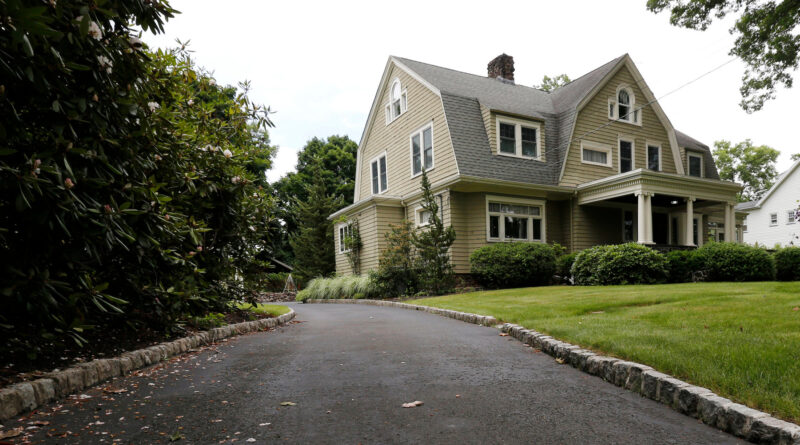The Watcher House in Westfield New Jersey
The story of the Watcher House is one of the most unsettling mysteries to emerge from the suburbs of Westfield, New Jersey. In June 2014, Maria and Derek Broaddus bought a six-bedroom colonial-style home at 657 Boulevard, with dreams of raising their three children in an idyllic neighborhood. However, their excitement quickly turned into horror when they began receiving a series of bizarre and threatening letters from someone who referred to themselves only as “The Watcher.” This unknown entity claimed to be obsessed with watching the house, setting off a real-life horror story that continues to baffle the community.
The Watcher House is no ordinary suburban legend—it’s a chilling tale of obsession, anonymity, and terror. The letters sent by the Watcher contained cryptic messages, personal threats, and eerie references to the family’s children, making the Broaddus family feel they were being watched by an unseen and sinister force.
The Broaddus Family
Maria and Derek Broaddus were moving from a smaller home in Westfield itself, just a few miles from 657 Boulevard. The family was not new to the area; Maria had actually grown up in Westfield, attending local schools and feeling deeply connected to the community. Derek was originally from Maine and had moved to New York City for work. The couple eventually settled in Westfield to raise their family, valuing the area’s reputation for good schools, low crime rates, and a family-friendly atmosphere.
At the time of purchasing 657 Boulevard, the Broaddus family lived in a modest home but had always aspired to live in a larger house with more space for their three children. The purchase of 657 Boulevard represented the culmination of their hard work and Derek’s successful career in insurance, where he had risen to become a senior vice president at a Manhattan insurance firm. The larger, historic home was intended to be their “forever home,” where they could watch their children grow up.
The Broaddus Children
The Broaddus family had three young children, who were central to their decision to purchase a bigger home. At the time, the children were aged 5, 8, and 10. The house offered plenty of space for the kids to play, both indoors and in the large backyard. However, they never got the chance to settle into their new home due to the fear instilled by the threatening letters.
The Broadduses’ Marriage and Family Life
Maria and Derek Broaddus had been married for about 14 years at the time they bought the house. As a couple, they were described by friends and neighbors as devoted parents who were actively involved in their children’s lives. Maria, a stay-at-home mother, was known to be warm, friendly, and closely connected to other parents in the Westfield community. She had returned to her hometown to be near family, including her parents who still lived in the area.
Derek was equally invested in family life despite his demanding career in Manhattan, often juggling work commitments with his children’s school and extracurricular activities. Friends described the Broaddus family as a typical, happy suburban family whose main concerns revolved around their children’s school activities, soccer games, and family gatherings. The decision to purchase a large home like 657 Boulevard was driven by their desire to create an ideal environment for their growing family.
The purchase of the historic home was not only meant to provide more space but also represented a personal achievement for the couple, symbolizing a milestone in their journey together. The house’s location was near Maria’s childhood neighborhood, making it feel like a return to her roots and a continuation of her family’s legacy in Westfield.
The First Letter: “I Have Been Watching the House for Decades”
Shortly after closing on their new home, Derek Broaddus, while painting late one evening, found an envelope addressed simply to “The New Owner.” This letter was the beginning of the Broaddus family’s nightmare. The sender, identifying themselves as “The Watcher,” wrote:
“657 Boulevard has been the subject of my family for decades now, and as it approaches its 110th birthday, I have been put in charge of watching and waiting for its second coming.”
The letter’s tone shifted from eerie to menacing, asking questions about why the Broaddus family had moved to the area and about their children:
“You have children. I have seen them. So far I think there are three that I have counted. Do you need to fill the house with the young blood I requested?”
The reference to “young blood” sent shivers down Derek’s spine, and he immediately alerted the local police. The initial investigation, however, provided no leads or clues about the identity of the Watcher.
The Broadduses began feeling paranoid and vulnerable in what was supposed to be their dream home. The possibility of someone watching them from the shadows or lurking nearby kept them on edge. In a town known for its quiet safety, the presence of a stalker was shocking and unnerving.
The Letters Intensify: “Welcome to Your Worst Nightmare”
The Broaddus family soon received a second letter from the Watcher. This time, the letter included more specific details about the family, indicating that the mysterious stalker had been closely observing them. The letter even referenced specific features of the house and rooms inside it, suggesting the sender was familiar with the layout. This knowledge led the Broaddus family to suspect that the Watcher might be a neighbor, or at least someone who had been inside the home.
The letter taunted them with lines such as:
“I am pleased to know your names now and the name of the young blood you have brought to me. Have you found all the secrets it holds yet? Will the young blood play in the basement?”
The basement, which was partially underground, became a particular focus of fear for the family, as it was a place where the children could play out of sight. The Broadduses feared that someone might be hiding in or around the house, given the sender’s intimate knowledge of its structure. This letter further cemented the sense of danger, with the Watcher implying that the family would never be able to enjoy peace at 657 Boulevard:
“The house is crying from all the pain it is going through. You have changed it and made it so fancy. You are stealing its history. It cries for the past and what used to be in the time when I roamed its halls.”
The Broadduses’ fears of being constantly watched became overwhelming. They started noticing cars idling near their home for suspiciously long periods, and Derek often patrolled the property late at night, trying to catch any unusual activity.
The Psychological Toll on the Broaddus Family
As the letters continued, the Broadduses began feeling the psychological toll of the constant fear and paranoia. Maria Broaddus was especially shaken, as she had grown up in Westfield and always considered it one of the safest towns in New Jersey. But with the threatening letters arriving regularly, she struggled to feel safe within her own home.
The third letter received by the Broaddus family was the most chilling of all. This one seemed to fixate even more on the children, suggesting that the Watcher had specific plans for them:
“I am in charge of watching and waiting for its second coming. The children are in the right place to draw them back into the circle of history. Who has the bedrooms facing the street? I’ll know as soon as you move in. It will help me to know who is in which bedroom.”
The specificity of the details and the sinister references to the children’s bedrooms prompted the Broadduses to abandon their plans to move in. Instead, they chose to live elsewhere while trying to determine who was sending these terrifying messages.
The financial and emotional toll of the situation was enormous. The Broadduses spent substantial amounts on legal fees, private investigators, and security systems, trying to identify the mysterious Watcher. Despite the constant surveillance and investigation, the Watcher’s identity remained elusive.
Suspects and Theories: Who Could Be “The Watcher”?
The question of who was sending the letters remains unanswered. Over the years, various theories have emerged about the Watcher’s identity and motives. Here are some of the most prominent theories that have been considered:
The “Disgruntled Neighbor” Theory
One theory suggests that the Watcher could be a disgruntled neighbor who was upset about the Broaddus family’s renovation plans. The extensive work the Broadduses had done on the house might have irritated a neighbor who valued the traditional appearance and history of the home. Some locals suggested that a neighbor who resented the changes to the house might have tried to frighten the family away with menacing letters.
Despite this plausible theory, no direct evidence ever linked any of the neighbors to the letters, and interviews with nearby residents yielded little information.
The “Former Owner” Theory
Some have speculated that the Watcher could be a former owner of the house or someone related to a previous owner. The Watcher’s letters often referred to the history of the home, suggesting a deep and personal connection to the property. The idea that the Watcher could be a descendant of a former resident, carrying on a twisted family tradition, adds a macabre dimension to the story. However, police investigations into past owners did not yield any solid leads, and none of the previous occupants reported receiving similar letters.
The “Real Estate Rival” Theory
Another theory is that the Watcher could have been someone with financial motivations, such as a rival in the competitive Westfield real estate market. The house at 657 Boulevard was highly sought-after, and some have speculated that a competing buyer might have used intimidation tactics to scare off the Broaddus family. While this theory fits with the high stakes of the housing market, it remains purely speculative, with no concrete evidence to support it.
The “Hoax” Theory
Some skeptics have suggested that the Watcher could be a hoax created by the Broadduses themselves. According to this theory, the couple could have fabricated the story in an attempt to get out of the purchase or to gain media attention. However, there are several problems with this theory. First, the Broadduses incurred significant financial losses and endured immense emotional distress from the incident. Second, their consistent cooperation with law enforcement and willingness to hire private investigators suggest they were genuinely seeking answers, not perpetrating a hoax.
The Aftermath: 657 Boulevard Today
The letters from The Watcher had a profound impact on the Broaddus family’s personal life. The stress and fear created by the correspondence took a toll on Maria and Derek’s mental and emotional well-being. They found themselves constantly on edge, trying to protect their children from an invisible threat while simultaneously navigating a complex police investigation. The couple even struggled to explain the situation to their children in a way that would not terrify them, opting to keep some of the more chilling details of the letters private.
The ordeal also strained their relationship as a couple. The pressure of being unable to move into their new home, the financial burden of maintaining two properties, and the constant paranoia of being watched created ongoing stress for both Derek and Maria. However, despite the significant challenges, they remained united in their efforts to uncover the identity of The Watcher and protect their family.
The Watcher letters left a lasting scar on the Broaddus family. They attempted to sell the house multiple times but faced significant challenges due to its newfound infamy. They moved out within six months of moving in, but the home sat on the market for years, as prospective buyers were scared off by the unsettling history associated with the property. In 2019, the Broadduses sold the house to new owners for $959,000, taking a substantial financial loss, but finally severing their ties to 657 Boulevard.
To this day, the mystery of the Watcher remains unsolved. The case has become part of American folklore, capturing the public’s imagination as one of the most bizarre and chilling stories of suburban terror. Despite the lack of a clear resolution, the tale of the Watcher House stands as a reminder that even in the safest neighborhoods, fear can sometimes lurk just beneath the surface.
Discover more from City Towner
Subscribe to get the latest posts sent to your email.




